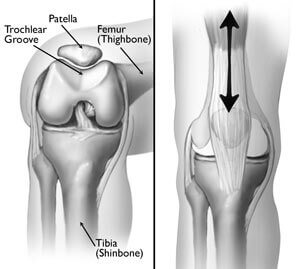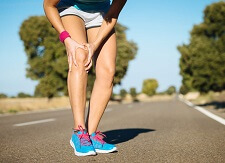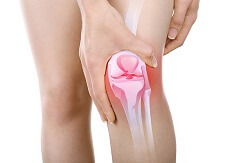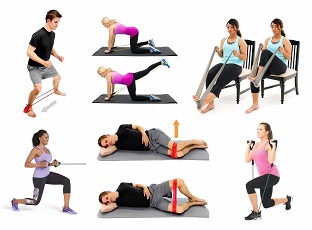- Home
- Common Knee Conditions
- Runners Knee
Runners Knee
Written By: Chloe Wilson, BSc(Hons) Physiotherapy
Reviewed by: KPE Medical Review Board
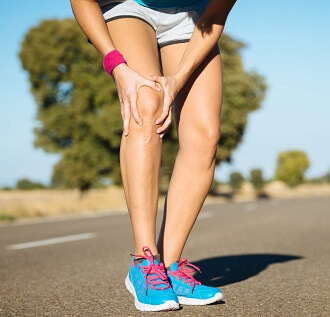
Runners Knee is one of the most common causes of front knee pain and accounts for approximately 25% of all knee injuries seen in sports injury clinics.
Runners Knee is also known as "Patellofemoral Syndrome" or "Anterior Knee Pain" and refers to pain under and around the kneecap.
It is caused by a problem with the way the knee cap moves resulting in friction on the back of the knee and is often linked with weak VMO muscles.
Symptoms tend to come on gradually and come and go depending on your activities. Runners Knee is not the only cause of knee pain from running and despite the name, it affects both active and sedentary people e.g. office workers.
Here we will look at the causes, symptoms, treatment options and recovery process from Runners Knee, frequently asked questions such as can I run on runners knee, as well as other knee conditions commonly misdiagnosed as Patellofemoral Syndrome.
What Is Runners Knee?
In Runners Knee, there is a problem in the way the patella (kneecap) moves. This places extra stress on the cartilage, resulting in front knee pain.
The kneecap sits in a groove, known as the patella or trochlear groove, at the front of the knee on the femur, thigh bone
It can glide, tilt and rotate upwards, downwards and sideways in this groove.
The knee cap is lined with very thick cartilage to help protect it from the large forces that go through the bone.
There are a number of things that stop the patella from moving properly, all of which increase the forces and friction going through the kneecap, causing patella femoral syndrome.
Causes Of Runners Knee
Common causes of runners knee include:
- Muscle Weakness: Weakness in the muscles reduces the support around the knee causing more weight to go through the kneecap. Also, if the muscles on one side of the knee are weak while the muscles on the other side are too strong, the kneecap will shift slightly to one side in the groove, resulting in friction
- Muscle Tightness: If the muscles around the kneecap are tight, they will pull it up slightly and possibly slightly to the side, increasing knee cap pain and friction
- Abnormal Foot Position: An abnormal foot position, such as flat feet, causes the foot to roll inwards which alters the way the forces go through the knee, increasing pressure on the kneecap
- Increased Q Angle: This refers to the angle of the thigh bone. An increase in the Q angle puts more strain on the kneecap
- Anatomy: There can be a problem with the shape of the groove and/or kneecap which result in the two not lining up properly which can restrict the movement and cause friction, predisposing you to patellofemoral syndrome
Symptoms of Patellofemoral Syndrome
Runners Knee usually comes on gradually – it is not triggered by a specific incident. People describe it as an ill-defined ache around the kneecap, particularly underneath and at the sides of the patella.
This helpful video from ClearDoc explains what is going on with the patella in patellofemoral syndrome.
There may also be grinding/grating sounds associated with
leg movement in patellofemoral syndrome – this is known as crepitus and
is caused by friction on the kneecap. Sometimes, there can also be some
front knee swelling.
Runners knee pain tends to come and go rather than being constant but is usually worse with:
- Prolonged Activity: e.g. running long distances, sports, skiing especially when going downhill
- Stairs: especially coming downstairs
- After Sitting for Long Periods: e.g. at the cinema, office workers, driving long distance. The knee tends to be sore when you first get up and then eases with movement
How To Treat Runners Knee
Treatment for Runners Knee aims to reduce the kneecap pain and swelling, and address any muscle imbalance in the leg. The most common treatments for patellofemoral syndrome are:
#CommissionsEarned from Amazon on qualifying purchases
1. Strengthening Exercises
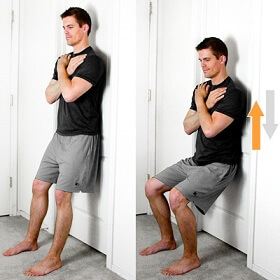
Strengthening exercises are key with patellofemoral pain syndrome as people with Runners Knee often have weak glutes (buttocks) and quads muscles. Strengthening these muscles will reduce the weight going through the knee and thus reduce knee pain.
In the knee strengthening section you will find a whole range of exercises that can help improve strength and stability and thus reduce runners knee pain.
Also, exercises that specifically target the muscles that control the kneecap make a massive difference, improving the way the kneecap glides in the patellar groove- see the kneecap exercises section for more information.
2. Stretches
Another important part of runners knee treatment is stretches. Reducing any muscle tightness through simple stretching exercises will also improve how the knee cap glides in the patellar groove reducing the friction on the kneecap.
Any tightness around the kneecap muscles will pull it slightly out of place resulting in increased friction and pressure on the knee cap, leading to runners knee.
Visit the knee stretches section for simple tests to see if muscle tightness is causing your patellofemoral syndrome pain and exercises that can help.
3. Knee Braces
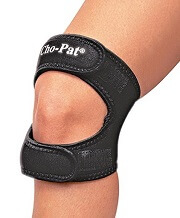
Another useful treatment tool with runners knee is a knee brace. Braces can help to improve the support around the knee and the position of the patella reducing the pain associated with patellofemoral syndrome.
There are a whole range of styles, but generally the best ones for Runners Knee have a hole at the front to prevent any extra pressure on the kneecap.
In the Knee Brace Guide section you can find loads of advice on how to find the right brace for you.
4. Orthotics
If your runners knee is linked in part with alltered foot biomechanics, then using orthotics can really help. Orthotics are special insoles that can be worn on your shoes to correct your foot position and Q angle and therefore reduce the forces going through the kneecap.
Your doctor can refer you to an orthotist to get your feet assessed and provide appropriate insoles or check out our favorite orthotics on our sister site or our Amazon US Storefront.
5. Rest and Pacing
Runners Knee often develops after an increase in activity levels. It may be advisable to rest for a few days to let your knee pain settle down, and then gradually build up the amount of exercise you do, or switch to non-impact exercise such as swimming.
Remember, pain doesn’t always come on during an activity, it often develops later that day or overnight, so start slowly and gradually increase.
6. Regular Ice
Using ice after activity can really help to reduce patellofemoral syndrome pain and swelling. It helps to reduce any inflammation and bleeding in the joint which helps to reduce pain and speed up healing.
Visit the Ice Treatment section for advice on how to safely and effectively use ice, and the ice wrap section for our top tips on the best ways to apply ice.
7. Avoid Prolonged Postures
If your runners knee pain comes on after sitting for long periods, try to avoid keeping your leg still.
At work, get up and have a little walk around every thirty minutes or so or if that’s not possible, gently move your leg backwards and forwards a few times. Another thing that can help reduce runners knee symptoms is to use a standing desk so you're not sitting all day.
This keeps the joint loose and lubricated which can help reduce patellofemoral syndrome pain.
8. Painkillers
Over the counter painkillers e.g. paracetamol/acetaminophen and non-steroidal anti-inflammatories e.g.
Advil/Ibuprofen can be useful to reduce the pain associated with Runners
Knee. Always consult your doctor before taking medication.
9. Surgery
It is very rare that patellofemoral syndrome requires surgery. However, if the above treatments do not work surgery may be indicated to release tight structures around the knee or to remove bits of bone that are irritating the knee cap. This is known as lateral release surgery.
The correct treatment will depend on the cause of your patellofemoral syndrome, so it is always advisable to see your Health Professional who can accurately assess what is causing your problem.
Runners Knee Recovery
It can take anywhere from six weeks to six months to recover from Runners Knee depending on how quickly you start treatment and how diligent you are.
It usually takes a few weeks of doing strengthening and stretching exercises for muscle strength and length to improve, so don’t give up. Also, don’t be tempted to increase your activity levels too quickly. Pace yourself so as not to aggravate your knee - check out our top tips on exercising.
If you want to keep exercising, try lower impact work such as swimming and cycling. If you do want to run, make sure you have good running shoes and try to avoid running on concrete as the hard surface puts more strain through the knee.
Common Misdiagnosis
There are a number of other conditions that cause front knee pain and Runners Knee is often incorrectly diagnosed as:
- Chondromalacia Patella: where there are actually changes in the cartilage lining the kneecap
- Jumpers Knee: irritation of the patellar tendon just below the knee
- Iliotibial Band Syndrome: irritation of the ITB on the outer side of the leg
Whilst these conditions may have similar presentations, there are important subtle differences to patellofemoral syndrome so do check out these other sections.
FAQs On Runners Knee
Here you will find answers to the most frequently asked questions about Runners Knee.
What Causes Runners Knee?
What Causes Runners Knee?
Patellofemoral pain syndrome is caused by the knee cap not moving correctly within the knee. This can be brought on by many factors, primarily muscle weakness and muscle tightness but also changes in your anatomy. For example, flat feet cause your foot to roll in, putting extra pressure on your knee.
How Do I Know If I Have Runners Knee?
How Do I Know If I Have Runners Knee?
The symptoms of Runners Knee usually come on gradually and pain is often described as an ache around the sides or behind the knee cap. It can be accompanied by a grinding sound or swelling. Pain tends to get worse with prolonged exercise, when coming downstairs or sitting for long periods.
To better diagnose your problem, visit our knee pain diagnosis section.
How Do You Get Rid Of Runners Knee?
How Do You Get Rid Of Runners Knee?
You can fix Runners Knee problems in a number of ways. In the short term, resting, ice therapy and Advil/Ibuprofen painkillers should help. Stretching and strengthening your knee is crucial to longer term improvement, especially VMO exercises. Knee braces and special insoles for your shoe may be required but you should seek advice.
How Long Will It Take For Runners Knee To Heal?
How Long Will It Take For Runners Knee To Heal?
It can take anywhere from 6 weeks to 6 months to recover from Runners Knee, which is also known as Patellofemoral Syndrome.
You can reduce immediate pain by resting and using ice therapy but strengthening your knee is key to long term recovery. It’s important to pace your exercise programme appropriately.
Do Braces Help Runners Knee?
Do Braces Help Runners Knee?
Knee braces can help reduce the symptoms of Runners Knee or Patellofemoral Syndrome by supporting the knee, taking pressure off the joint and improving the position of the kneecap. The ones that work best are knee straps or braces that have a hole at the front so there is support but no pressure through the kneecap.
Can I Run On Runner's Knee?
Can I Run On Runner's Knee?
It is advisable to rest from aggravating activities if you have patellofemoral syndrome. You can continue to exercise with runner's knee but it helps to reduce the time and distance you run for to allow the knee to heal or switch to low impact activities such as swimming or cycling.
How Do You Prevent Runners Knee?
How Do You Prevent Runners Knee?
Preventing runners knee is primarily about good stretching and good strengthening exercises. Patellofemoral syndrome is caused by the knee cap not gliding smoothly and stretching ensures muscle tightness doesn’t negatively impact movement. Strengthening the leg muscles lowers the impact of forces on the knee bones. Shoe insoles may sometimes be needed.
Want To Know More?
If Runners Knee isn't sounding quite like your problem and you want help working out what is wrong with your knee and why you have pain, visit the knee pain diagnosis section.
You may also be interested in the following articles:
Related Articles
Last Updated: September 10th, 2025
Next Review Due: September 10th 2027
